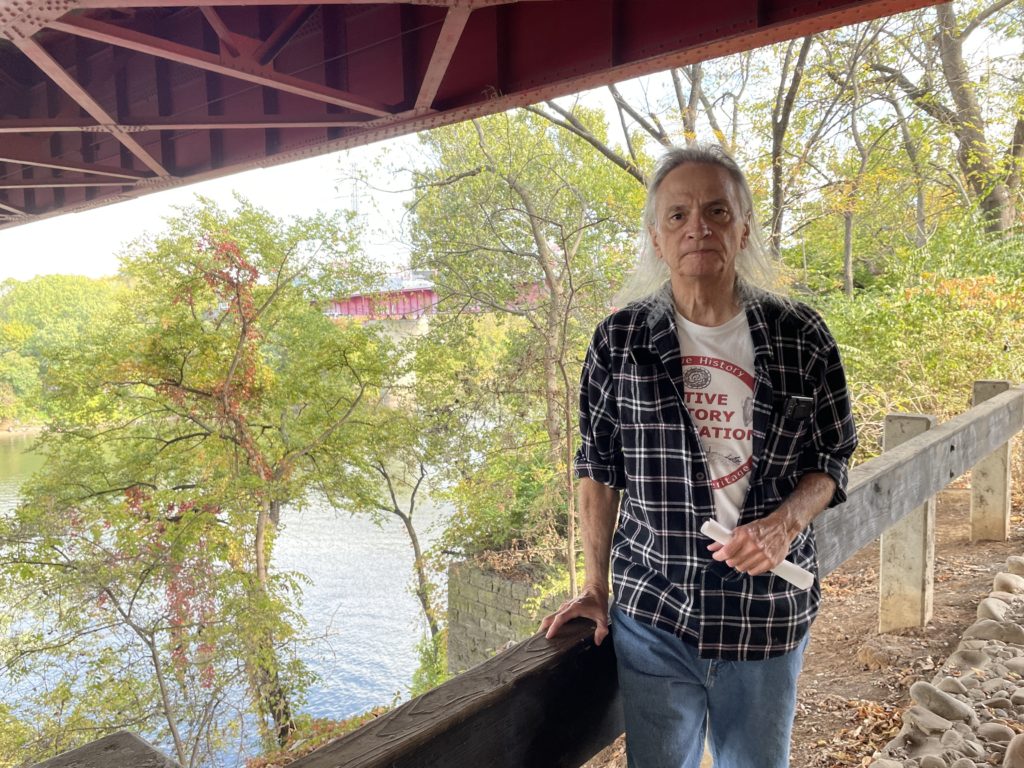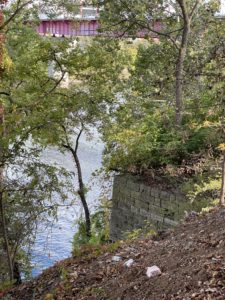
Nearly 200 years ago, about a thousand Cherokee people passed through Nashville, almost all of them on foot, and crossed over the Cumberland River on the Nashville Toll Bridge. That bridge is gone, but today one part of the original structure, a stone abutment, still stands on the west bank of the river.
Forced migration
The Cherokee were on their way to Indian Territory, in present-day Oklahoma. This group was the first of 11 such processions, known as detachments, who went this way on the northern route. It was a difficult journey — one they were forced to take. For about a quarter of the people who walked what is known as the Trail of Tears, the journey was fatal. The Cherokee were not alone. Under the Indian Removal Act, members of the Chickasaw, Choctaw, Muscogee and Seminole nations were also forced to leave their ancestral lands.
To reach the bridge, the first detachment of Cherokee who passed through Nashville walked up Second Avenue, right through what is now the heart of city’s tourist district. At the corner of Second and Commerce, I meet up with Toye Heape. He’s vice president of the Native History Association, and he’s been researching the Trail of Tears for quite some time. He says there’s a newspaper account that corroborates October 15, 1838, as the date the first Cherokee traveled this route.
Then, he unrolls a map that shows how the streets were configured back in 1838.
Passing through the city center
 “So they came in on Murfreesboro Road and it runs into Lafayette Street,” Heape explains. From there, they could have gone up First Avenue, which was known as Water Street at the time. “But that was where the wharf was, where they unloaded the steamboats, and it was incredibly busy.”
“So they came in on Murfreesboro Road and it runs into Lafayette Street,” Heape explains. From there, they could have gone up First Avenue, which was known as Water Street at the time. “But that was where the wharf was, where they unloaded the steamboats, and it was incredibly busy.”
Back then Second Avenue was called Market Street, and it would have made a lot more sense to go this way to avoid the traffic jam at the wharf. It was also less steep.
“What the citizens of Nashville would have seen at the time was a line … a thousand people long, probably in single file or two abreast to avoid blocking the road,” he says. “And even though they had supply wagons, almost all of them walked.”
Heape says they would have been dressed a lot like the people in Nashville at the time. A thousand people walking together through downtown might seem conspicuous. But there’s little record of Nashvillians taking much notice.
“It’s kind of odd because the newspapers before, from early 1838 when they were doing the roundup and everything … they have a lot of news about the roundup,” Heape says. “But then when they actually start coming through, there’s only a few articles … and basically that’s all they say.”
Tracing their route
It’s a little jarring, walking this path today, with the noisy backdrop of tourists and bars. We continue walking north up Second Avenue, surrounded by construction barricades, until we reach the Public Square.
“The square was basically in the same place, but it was laid out different,” Heape says. The courthouse was on the east end, and the market house to the west. There were also a couple of hotels back then. Today, there’s a man playing catch with his dog on a patch of grass as we walk over the same land that the Cherokee crossed over on their way to the Nashville Toll Bridge.
At the time, it was the only way to cross the Cumberland without taking a ferry — which, for a group this size, wouldn’t have been practical. The bridge is probably one of the main reasons the Cherokee came through Nashville. It was a covered bridge with two lanes of traffic, and a pedestrian walkway on each side.
Related: Exploring Middle Tennessee’s native roots and what it means to be indigenous
 Steve Haruch, WPLN
Steve Haruch, WPLN One of the interpretive plaques at the Nashville Toll Bridge location
The remains of the Nashville Toll Bridge
We head east across the square and down a set of stairs to Gay Street where there are two interpretive plaques, which Heape worked on getting installed. One is dedicated to the history of the bridge itself, which was designed by a man named Louis Wernwag.
“He was a big deal in 19th century engineering,” Heape says. “He’s a very significant figure. So when we were communicating to the National Park Service, we’re telling them, so this is a Louis Wernwag bridge. They were like, ‘Wow’ …They were really excited about that because he’s a big deal.”
The other plaque is dedicated to the removal of the Cherokee and the Trail of Tears. Looking up from the plaques all, we can really see is a chain link fence, and a lot of brush and weeds. We actually have to walk about 20 feet to the left before we can look back behind where the plaques are. And then, we see it.
It’s a large rectangular abutment built out of cut stone. From here we can see the north side — or at least the top of it. We can’t see the base of the structure. Looking toward the river gives some sense of how far down it goes.
“When you when you’re down on the riverbank looking up at it,” Heape says, “that’s when it really makes its impact on how how massive it was.”
A troubled legacy
 Steve Haruch, WPLN
Steve Haruch, WPLN The last remaining abutment of the Nashville Toll Bridge.
Standing here, I try to imagine what it would have been like to leave your home behind, walking hundreds of miles on foot, toward an uncertain future in a place you’d never seen. I have to admit — it’s kind of overwhelming. I ask Heape how he’s feeling. He hesitates for a moment.
“I try to stay focused on the historical aspect of it,” he says. “It’s a disturbing episode. … It’s something that that never should have happened. You know, it’s really easy to get lost in there. And you just start thinking … ‘I just can’t think about this anymore.’ ”
He also says we should remember that while this is a story of loss, it’s also a story of a people overcoming tremendous hardship. The Cherokee culture is still alive today despite everything it has endured.
“You see all those people on Second Avenue and, you know, there would be a certain percentage of them, I think, that would be interested in knowing that this is down here,” he says.
Heape hopes that more signage and plaques will make the Trail of Tears more visible here in Nashville.
“That would be a good thing,” he says.
This first aired during Monday’s This Is Nashville episode about the Trail of Tears, which can be found here.


